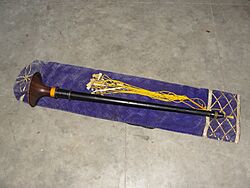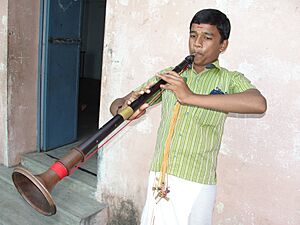Nadaswaram facts for kids

A Nadasvaram with seevali
|
|
| Double reed wind | |
|---|---|
| Other names | Nagasvaram |
| Classification | Wind instruments |
The nadaswaram (pronounced nah-dah-swah-rahm) is a special wind instrument from South India. It's like a big, loud oboe. People play it in traditional Carnatic music concerts.
You can hear the nadaswaram in Tamil Nadu, Andhra Pradesh, Telangana, Karnataka, Kerala, and parts of Sri Lanka. It's known for being one of the loudest non-brass instruments in the world!
This instrument is very important in South Indian culture. It's often played at Hindu weddings and in temples. People believe it brings good luck. That's why it's called a mangala vadyam, which means "auspicious instrument."
Nadaswarams are usually played in pairs. They are often joined by drums called thavil. Sometimes, another instrument called an ottu plays a steady drone sound with them.
History of the Nadaswaram
The nadaswaram has a very long history. Ancient Tamil writings mention instruments that sound like it. One old text, the Silappatikaram, talks about an instrument called the "vangiyam."
The "vangiyam" had a similar shape to the nadaswaram. It also had seven holes for fingers. Because of this, it was sometimes called "eḻil," meaning "seven." This instrument is still popular today, especially among Tamils living in other countries.
How the Nadaswaram is Made
The nadaswaram has three main parts. These are the kuḻal, the thimiru, and the anasu.
It's a double reed instrument. This means it has two small pieces of reed that vibrate to make sound. The instrument gets wider towards the bottom.
At the top, there's a metal piece called the mel anaichu. A small metal tube, the kendai, fits into it. This tube holds the reed mouthpiece. Players also keep a small needle to clean the reed. This helps the air flow freely. At the very bottom, there's a metal bell called the keeḻ anaichu.
Traditionally, nadaswarams were made from a tree called aacha. Today, other materials are used too. These include bamboo, sandalwood, copper, brass, ebony, and even ivory. Older wood is thought to be the best for wooden instruments. Sometimes, wood from old houses is used!
The nadaswaram has seven holes for fingers. It also has five extra holes at the bottom. These can be blocked with wax to change the sound. The instrument can play a wide range of notes, about two and a half octaves. This is similar to the Indian bansuri flute.
Unlike a flute, where you partly open holes for different notes, the nadaswaram is different. Players change the sound by changing how much air they blow. They also change how strong the air is. Because it's so loud, the nadaswaram is best played outdoors. It's perfect for open spaces, not small concert halls.
Famous Nadaswaram Players
Many talented musicians have played the nadaswaram. Here are some of the most famous ones:
- Thirumarukal Nadesa Pillai
- T.N. Rajarathnam Pillai (1898–1956)
- Thiruvengadu Subramania Pillai
- Karukurichi Arunachalam (1921–1964)
- Kulikkarai P Rajendran Pillai (1970–2019)
- M.S. Ponnuthayi (1928–2012)
- Thiruvizha Jayashankar (born 1940)
- Sheik Chinna Moulana (1924–1999)
- Namagiripettai Krishnan (1924–2001)
- Madurai M.P.N. Sethuraman (1928–2000)
- M.P.N. Ponnuswamy (1932–2023)
- S. R. D. Vaidyanathan (1929–2013)
- Domada Chittabbayi (1930–2002)
- Umapathy Kandasamy (1950–2017)
Some musicians from other countries have also learned to play the nadaswaram. Charlie Mariano (1923–2009) was one of the few non-Indian jazz musicians who played it. He studied the instrument while living in India. Other musicians like Vinny Golia and William Parker have also performed with it.
See also
- Tavil
- Stone nadasvaram


